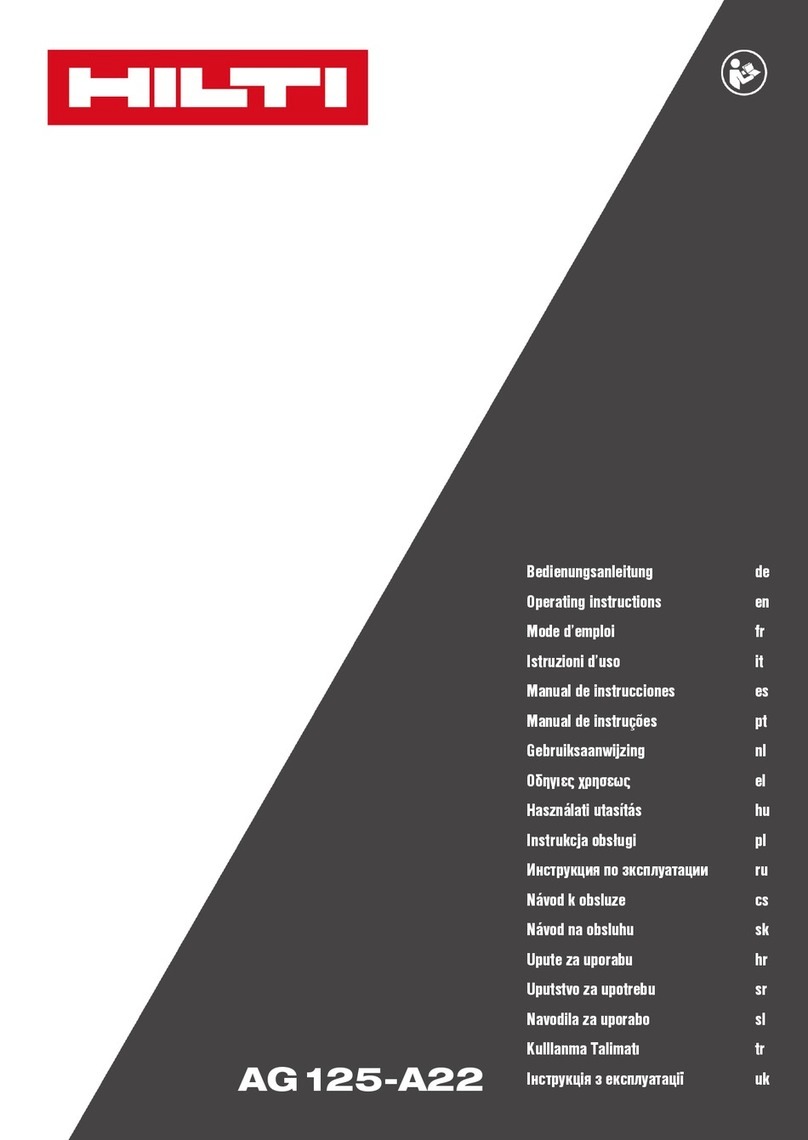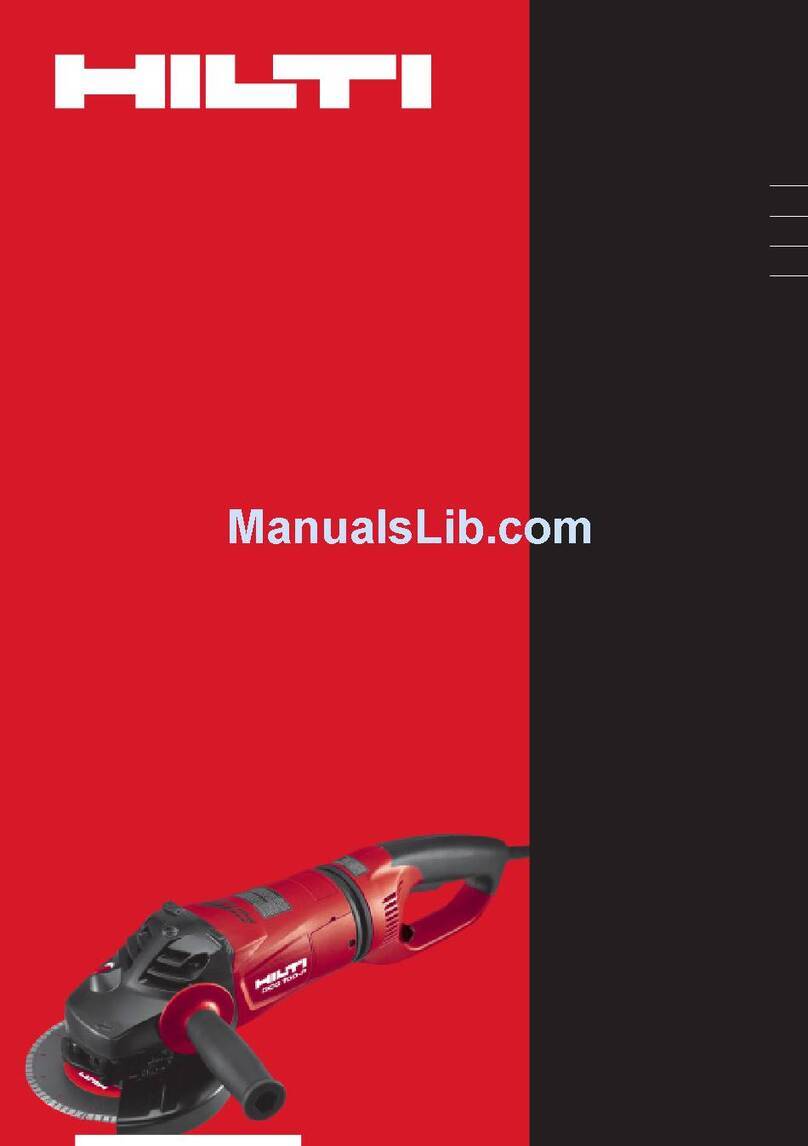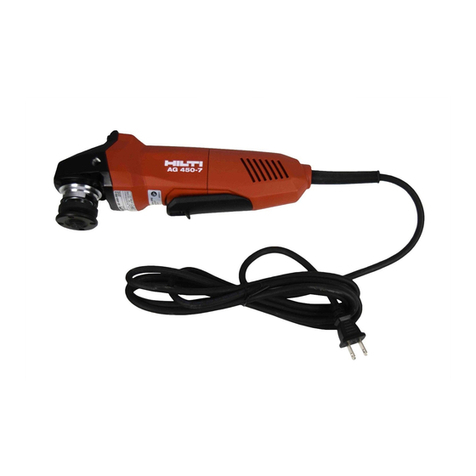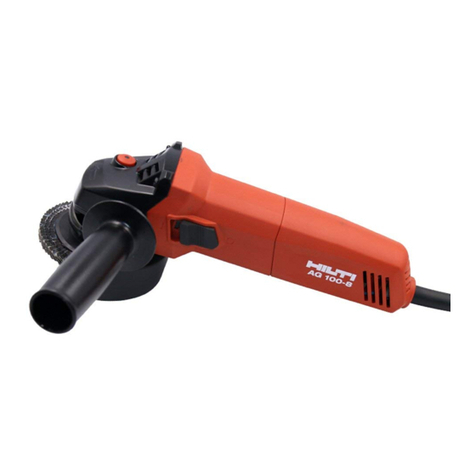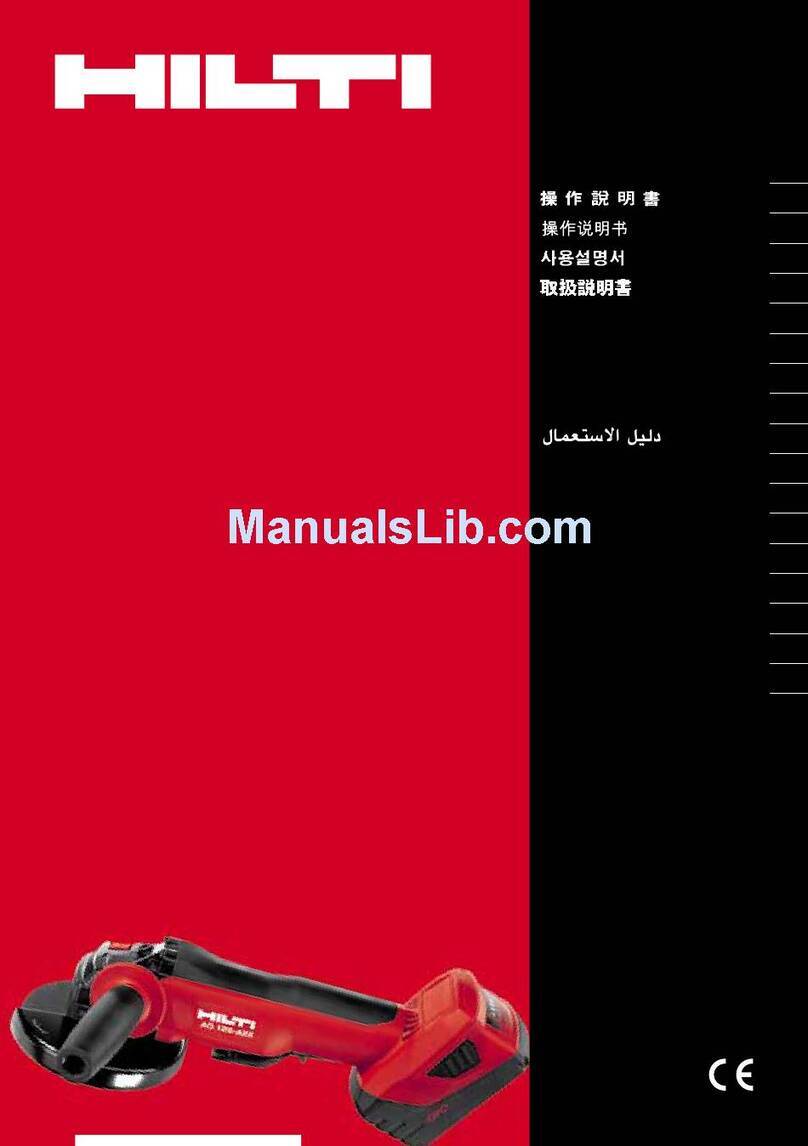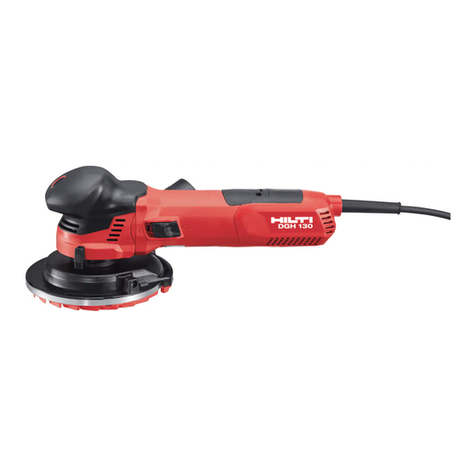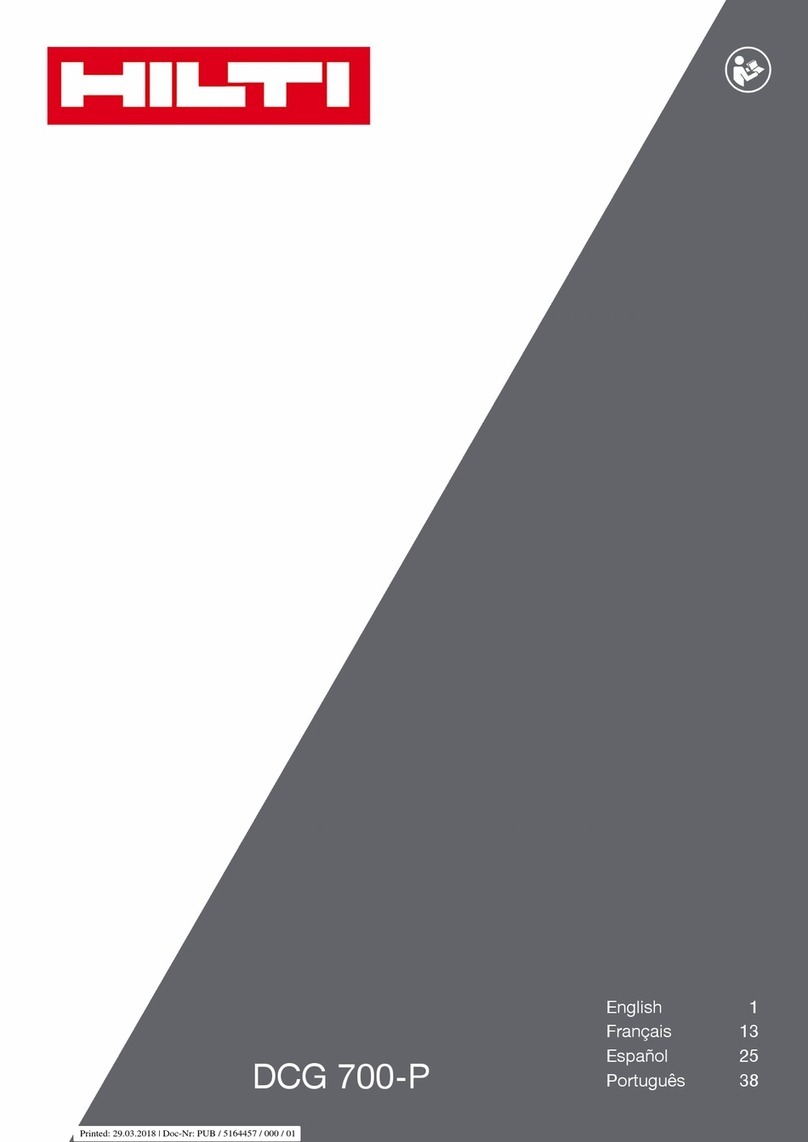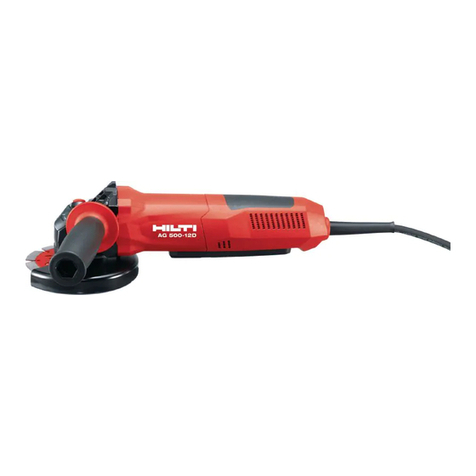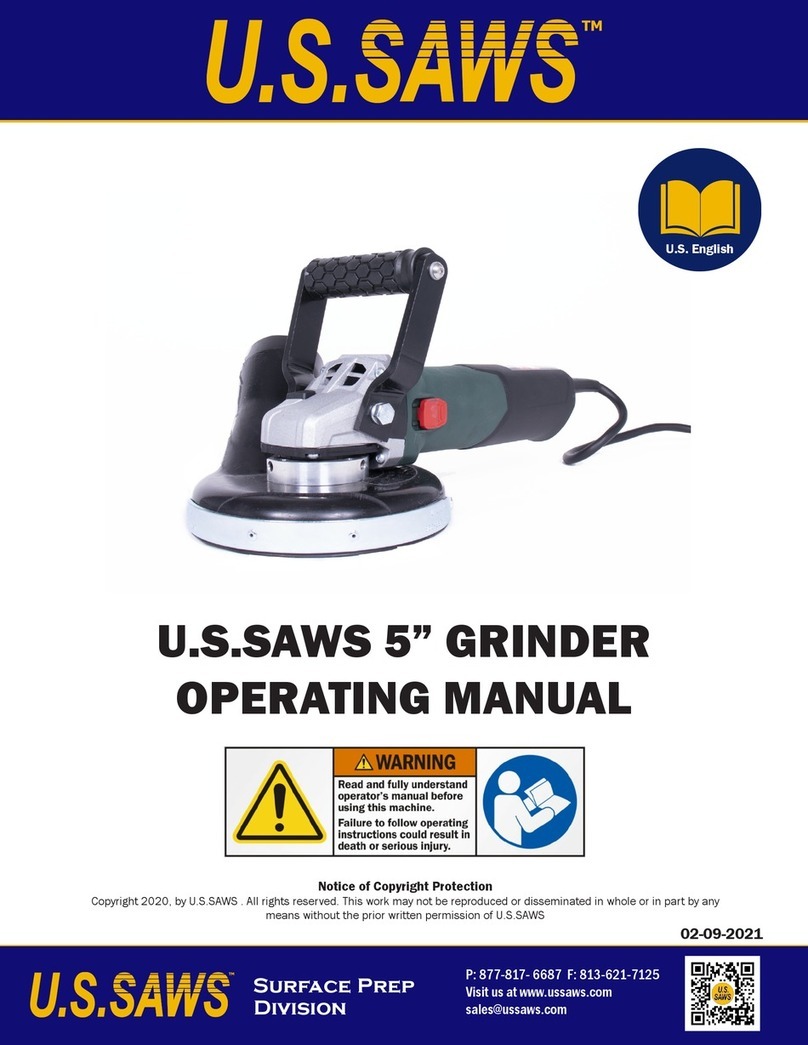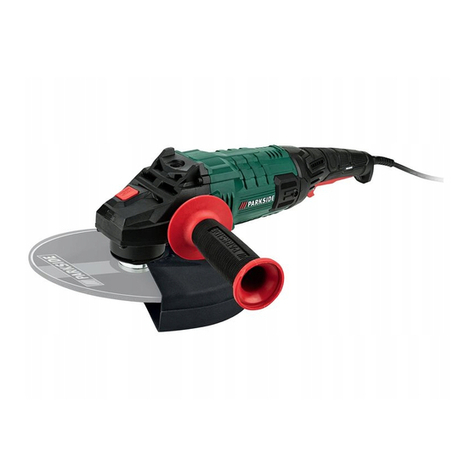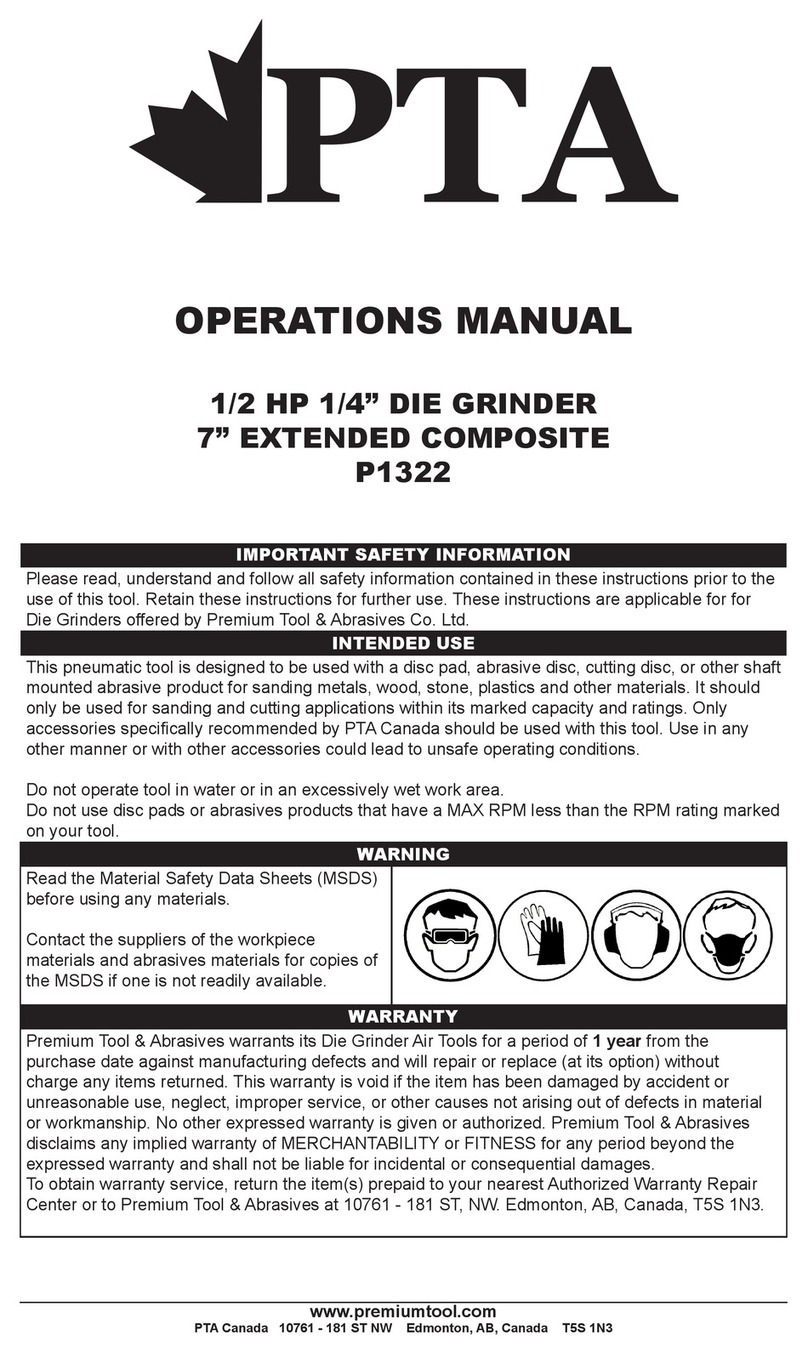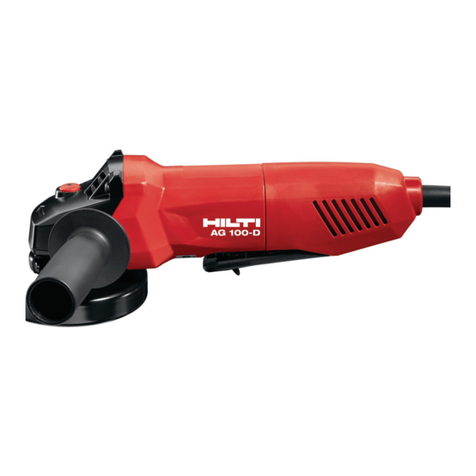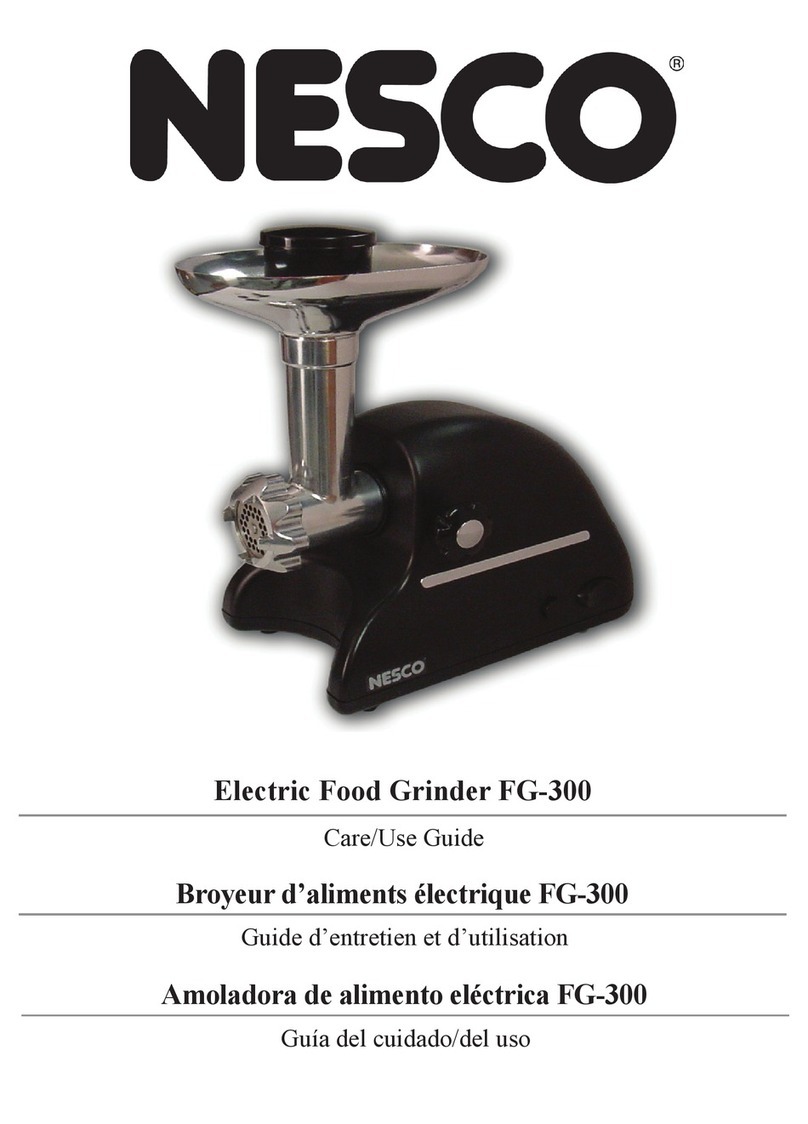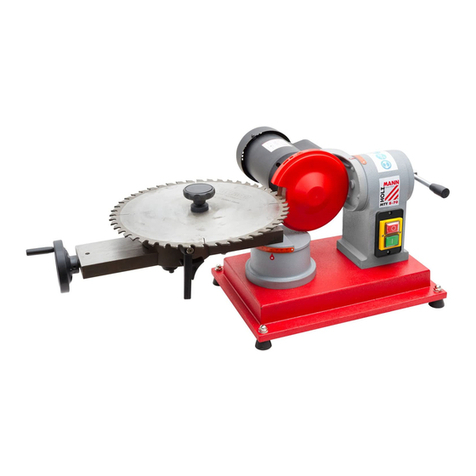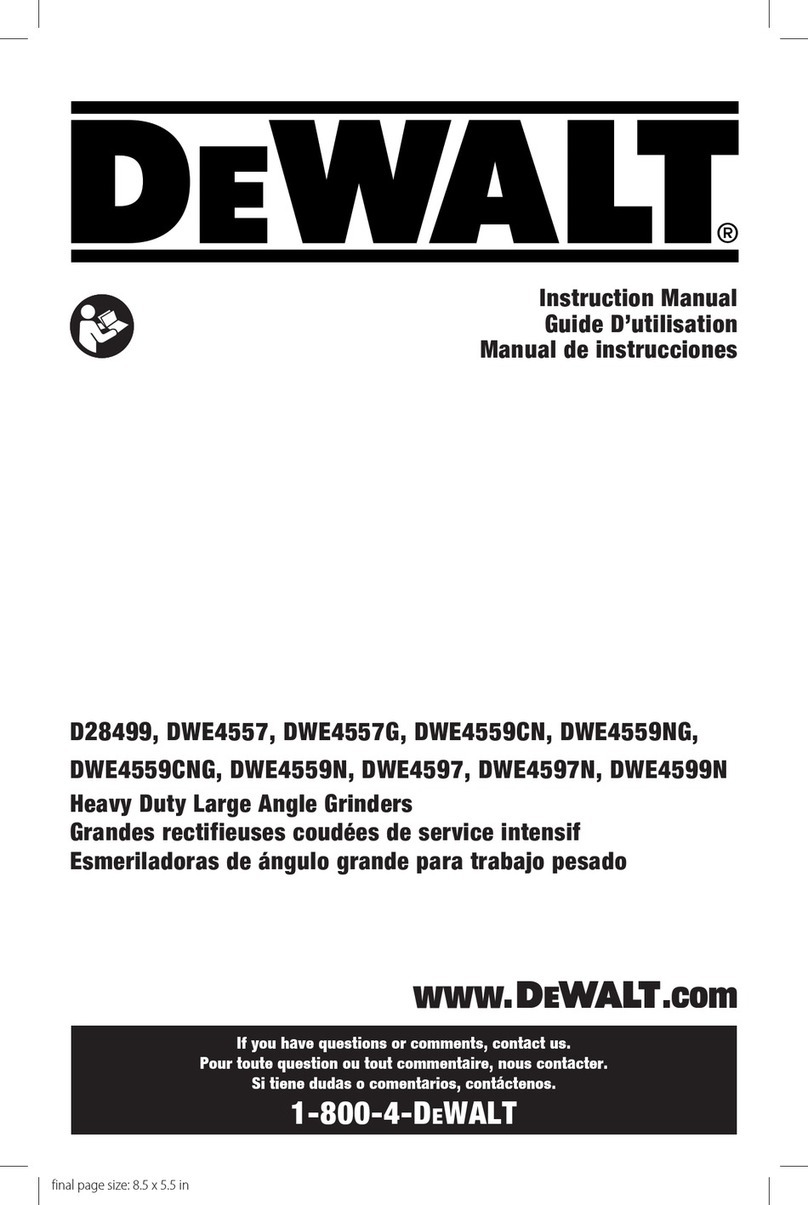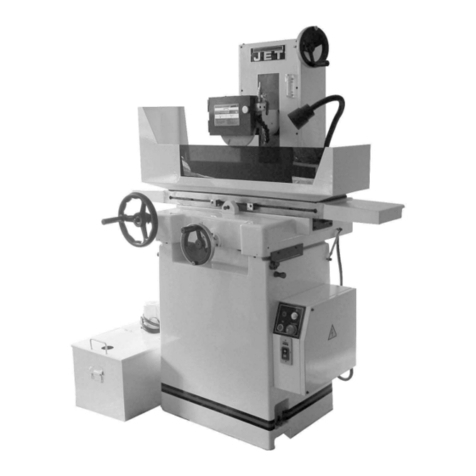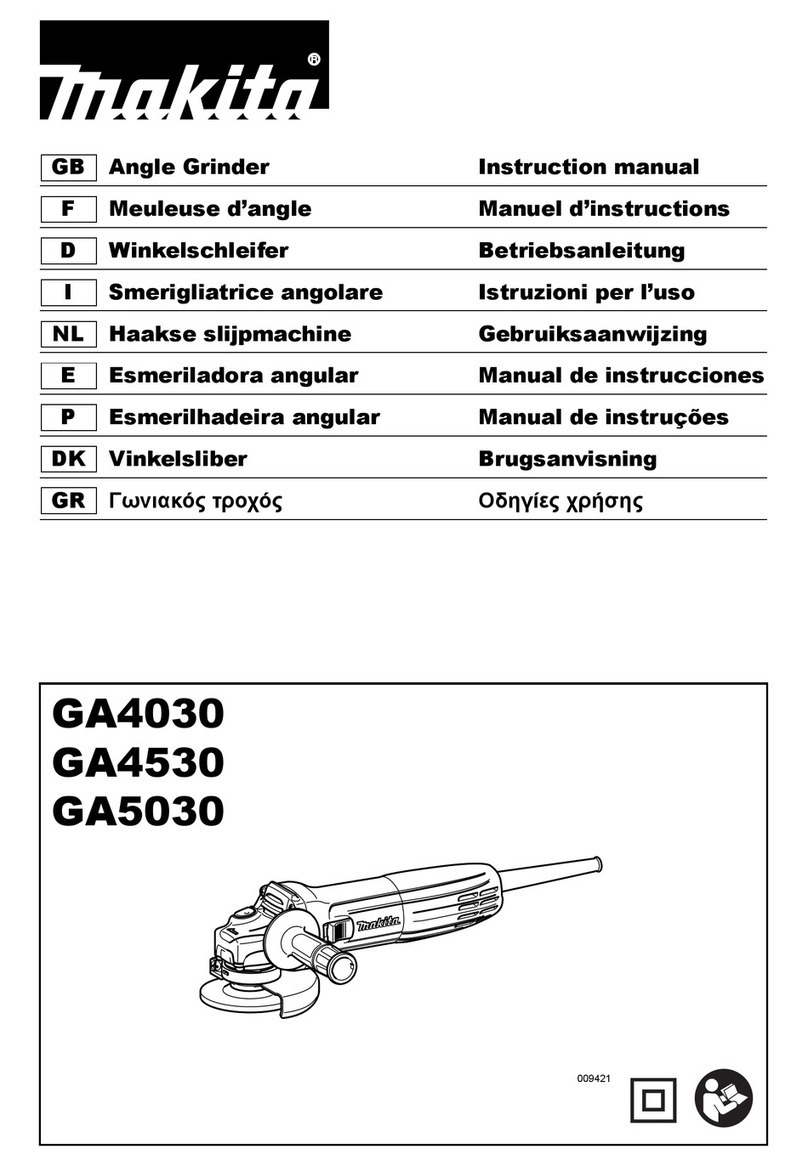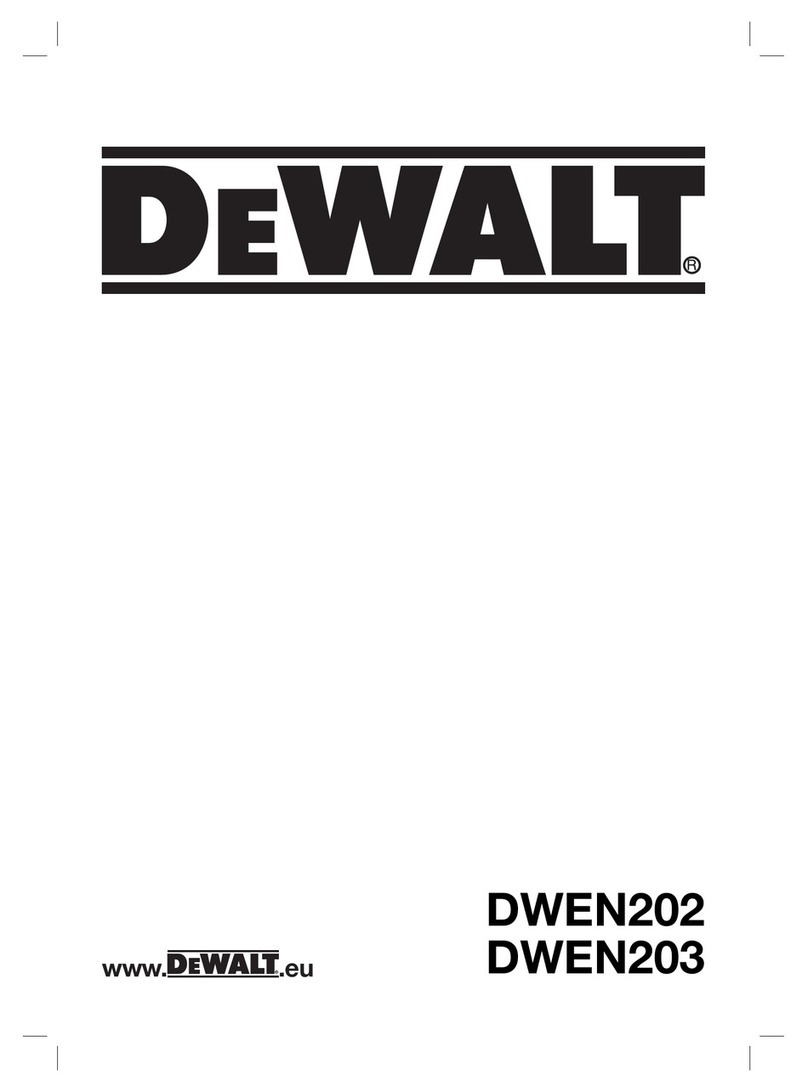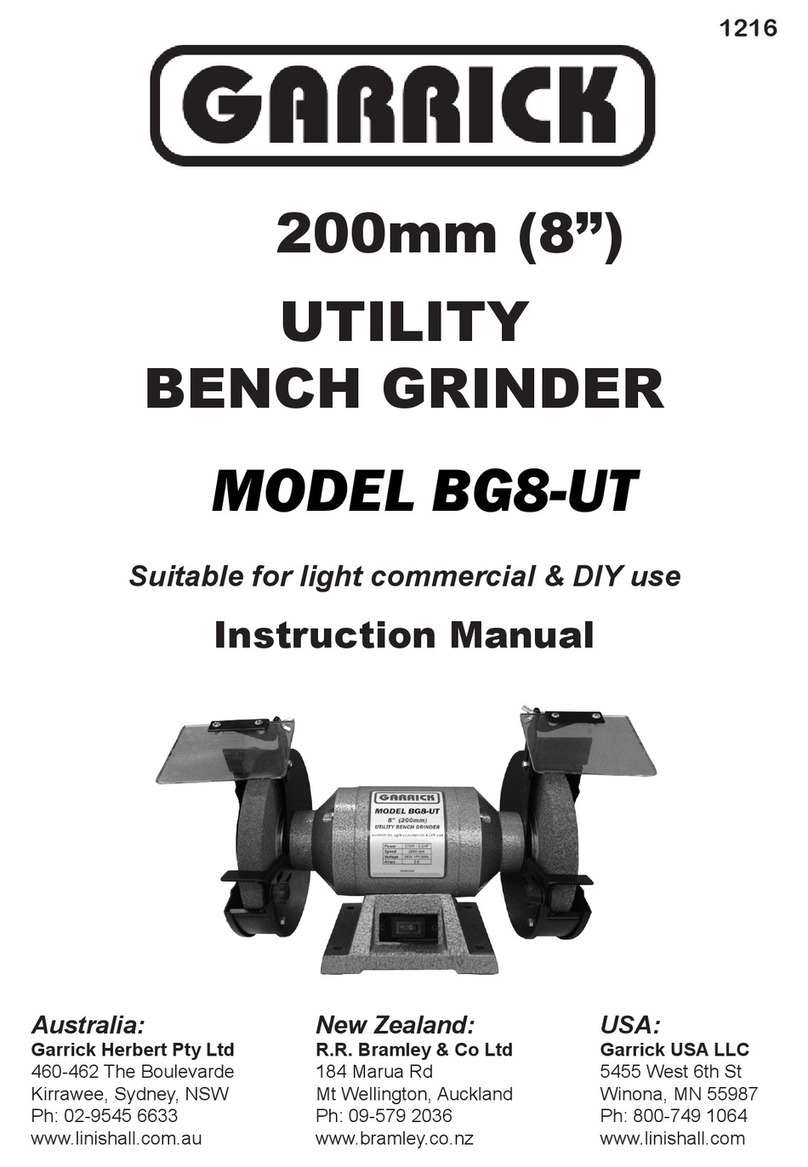DIAMOND GRINDER
SAFETY SHEET
(Hilti DG150)
SAFETY INFORMATION
• This power tool is intended to function as a grinder. Read all safety
warnings, instructions, illustrations and specications provided with this
power tool. Failure to follow all instructions listed below may result in
electric shock, re and/or serious injury.
• Operations such as sanding, wire brushing polishing or cutting are not
recommended to be performed with this power tool. Operations for
which the power tool was not designed may create a hazard and cause
personal injury.
• Do not use accessories which are not specically designed and
recommended by the tool manufacturer. Just because the accessory can
be attached to your power tool, it does not assure safe operation.
• The rated speed of the accessory must be at least equal to the maximum
speed marked on the power tool. Accessories running faster than their
rated speed can break and y apart.
• The outside diameter and the thickness of your accessory must be within
the capacity rating of your power tool. Incorrectly sized accessories
cannot be adequately guarded or controlled.
• Threaded mounting of accessories must match the grinder spindle
thread. For accessories mounted by anges, the arbour hole of the
accessory must t the locating diameter of the ange. Accessories that
do not match the mounting hardware of the power tool will run out of
balance, vibrate excessively and may cause loss of control.
• Do not use a damaged accessory. Before each use inspect the accessory
such as abrasive wheels for chips and cracks, backing pad for cracks,
tear or excess wear, wire brush for loose or cracked wires. If power tool
or accessory is dropped, inspect for damage or install an undamaged
accessory. After inspecting and installing an accessory, position yourself
and bystanders away from the plane of the rotating accessory and run
the power tool at maximum no-load speed for one minute. Damaged
accessories will normally break apart during this test time.
• Wear personal protective equipment. Depending on application, use face
shield, safety goggles or safety glasses. As appropriate, wear dust mask,
hearing protectors, gloves and workshop apron capable of stopping small
abrasive or workpiece fragments. The eye protection must be capable of
stopping ying debris generated by various operations. The dust mask
or respirator must be capable of ltrating particles generated by your
operation. Prolonged exposure to high intensity noise may cause hearing
loss.
• Keep bystanders a safe distance away from work area. Anyone entering
the work area must wear personal protective equipment. Fragments
of workpiece or of a broken accessory may y away and cause injury
beyond immediate area of operation.
• Hold the power tool by insulated gripping surfaces only, when performing
an operation where the cutting accessory may contact hidden wiring
or its own cord. Cutting accessory contacting a “live” wire may make
exposed metal parts of the power tool “live” and could give the operator
an electric shock.
• Position the cord clear of the spinning accessory. If you lose control, the
cord may be cut or snagged and your hand or arm may be pulled into the
spinning accessory.
• Never lay the power tool down until the accessory has come to a
complete stop. The spinning accessory may grab the surface and pull the
power tool out of your control. Do not run the power tool while carrying it
at your side. Accidental contact with the spinning accessory could snag
your clothing, pulling the accessory into your body.
• Regularly clean the power tool’s air vents. The motor’s fan will draw the
dust inside the housing and excessive accumulation of powdered metal
may cause electrical hazards.
• Do not operate the power tool near ammable materials. Sparks
could ignite these materials. Do not use accessories that require liquid
coolants. Using water or other liquid coolants may result in electrocution
or shock.
• Maintain a rm grip on the power tool and position your body and arm
to allow you to resist kickback forces. Always use auxiliary handle, if
provided, for maximum control over kickback or torque reaction during
start-up. The operator can control torque reactions or kickback forces, if
proper precautions are taken.
• Never place your hand near the rotating accessory. Accessory may
kickback over your hand. Do not position your body in the area where
power tool will move if kickback occurs. Kickback will propel the tool in
direction opposite to the wheel’s movement at the point of snagging.
• Use special care when working corners, sharp edges etc. Avoid
bouncing and snagging the accessory. Corners, sharp edges or
bouncing have a tendency to snag the rotating accessory and cause
loss of control or kickback.
• Do not attach a saw chain woodcarving blade or toothed saw blade.
Such blades create frequent kickback and loss of control.
BASIC OPERATION
Adjusting the guard
1. Set the device on the work surface.
2. Release the clamping lever.
3. Turn the retaining ring with lamellar seal until the gap between lamellar
seal and work surface is correct.
4. Turn the guard to the desired position.
5. Close the clamping lever.
Adjusting the guard for working close to an edge
1. Release the clamping lever.
2. Turn the top part of the guard relative to the bottom part until the
desired position is reached.
3. Set the device on the work surface.
4. Turn the retaining ring with lamellar seal until the gap between lamellar
seal and work surface is correct.
5. Close the clamping lever.
Adjusting the side handle
1. Slacken the side handle by turning the securing screw counter-
clockwise.
2. Swing the side handle forward or back to the desired position.
3. Secure the side handle by turning the securing screw clockwise.
Fitting a diamond cup wheel
1. Fit the clamping ange onto the spindle with the O-shaped depression
facing the tool, so that the clamping ange engages (keyed t).
2. Fit the grinding disc onto the centering collar on the clamping ange.
3. Screw on the clamping nut in a clockwise direction and then use the
wrench to tighten it against the resistance of the motor/gearing.
Removing the diamond cup wheel
1. Press and hold down the arbor lockbutton.
2. Release the clamping nut by gripping it with the wrench and turning the
nut counter-clockwise.
3. Remove the clamping nut.
4. Release the arbor lockbutton and remove the diamond cup wheel.
Setting the speed of the diamond cup wheel
1. Use speed I for better dust control when grinding o soft mineral
materials, such as paint from cement rendering, and to make the power
tool easier to guide when grinding o coatings from soft materials.
2. Use speed II to apply the full power of the tool when grinding hard
mineral materials such as concrete,oor screeding or natural stone.
Switching on
1. Connect the grinder to an industrial vacuum cleaner.
2. Plug the grinder’s supply cord plug into the power outlet of the DPC 20.
3. Plug the DPC 20 into the power outlet of the electricity supply. The LED
lights green.
4. Lift the power tool clear of the work surface.
5. Push the on/o switch forward to the on position (I). The on/o switch
engages in the on position (I).
Grinding
1. Always keep the grinder close to the work surface.
2. Move the device back and forth.
3. Apply moderate pressure and do not dig the tool into the material.
Switching o
1. Press the on/o switch. The on/o switch goes to the o position (0)
when released.
2. Disconnect the supply cord plug from the power outlet.
3. If an industrial vacuum cleaner was in use, disconnect the hose
connection between the device and the industrial vacuum cleaner.

